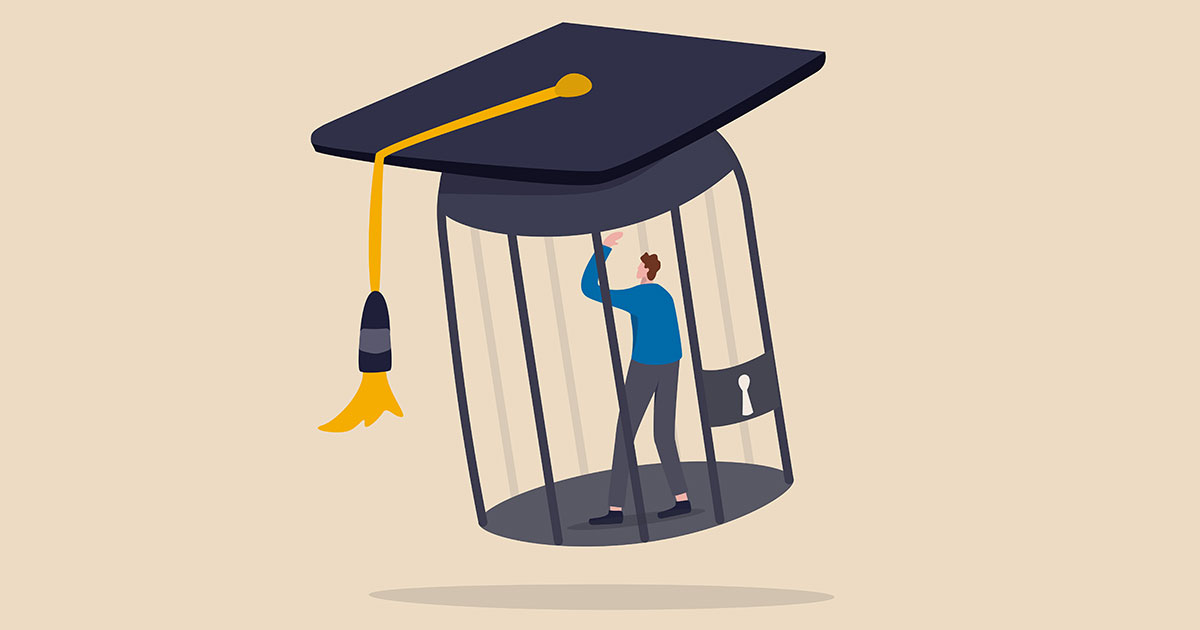
Oct. 20, 2021 – There is no doubt that I am still a government attorney because of a program called
Public Service Loan Forgiveness (PSLF).
Created by the federal government in 2007, one of its goals was to incentivize professionals to work in public service by erasing student loan balances for certain debtors who work in that field for 10 years.
First, My Story
As a 2008 law school graduate who had just started a job with a municipality, I jumped at the PSLF program as soon as possible. Given the six-figure debt I carried out of law school, PSLF converted my desire to work in public service from financially irresponsible to feasible – or at least feasible in theory.
The program was deceptively simple: make 120 qualified payments on a qualified loan while working for a qualified employer. (For those keeping track at home, yes, the word “qualified” appears three times in that sentence. That is a lot of moving parts to line up correctly when the stakes are so high.)
 Kail Decker, Marquette 2008, is the West Allis City Attorney and received loan forgiveness under the Public Service Loan Forgiveness program in 2019.
Kail Decker, Marquette 2008, is the West Allis City Attorney and received loan forgiveness under the Public Service Loan Forgiveness program in 2019.
The qualifications attached to the payment plan, loan type, and employer for PSLF became more complicated the closer one looked at each part. The program was filled with traps, because there was no way to obtain legally enforceable assurance that you were doing things correctly along the way – you simply had to find out 10 years later if you did things correctly.
On March 7, 2019, I made my 120th payment. Soon after, I applied for forgiveness, and subsequently joined the 62,686 public servants at that time who have had their applications denied.
The reason for the first rejection was I electronically submitted documents separate from the application instead of attaching them to the application. A few months later, my second application was rejected because I electronically signed the application in response to the online tool asking me if I'd like to sign electronically.
I had no choice but to persist.
It was 11:04 p.m. on Friday, July 26, 2019. I was getting ready to go to sleep after traveling 3 ½ hours to stay at a cabin with my wife and another couple for the weekend. I was making my way to bed when my phone alerted me to a new email. Already half-asleep, I glanced at the screen to see it was from FedLoan Servicing. I enjoy ignoring technology in situations like this, but my anxiety would not let me leave the message unread. With a clenched jaw, I opened the email expecting to discover a new obscure roadblock in my path.
To my surprise, the attachment was a letter from FedLoan informing me that my entire student loan balance was discharged by the U.S. Department of Education. Two zeros appeared where a nearly six-figure debt stood the day before.
The end result? I effectively got a raise, lowered my anxiety levels, raised my credit score, and purchased items that I had been deferring for years. It was such a difference that I spent more money while also saving more money.
I don’t know exactly what changed between my second and third attempts, but for me, the third time was indeed the charm.
I enjoy public service work and find it fulfilling, and PSLF allowed me to avoid the temptation of higher earnings in the private sector. Now that I have worked in public service for more than 10 years, I have built a specialty in the field, and have a professional incentive to stay after my loans are forgiven. I can see myself as a lifelong public servant, and the PSLF program was the largest single factor in making that happen.
The Debt Load of 2020 Law Grads
While I carried a fair amount of student loan debt out of law school, my balance was nothing like the amounts students and recent graduates face today.
In 2020, U.S. law school graduates entered the workforce with almost $2.75 billion in student loan debt.
U.S. News compiled data from 183 law schools (out of 197 existing), and found about three out of four law students graduated with debt and they carried an average balance of $118,068.
The University of Chicago had the highest average debt per student in the nation at $191,117. On the other hand, 92 percent of students at Ave Maria in Florida left with debt, the highest proportion of debtors in the country.
To show this is a local issue too, 83 percent of the 2020 Marquette University Law School graduates left school with debt – their average debt was $142,143.
The 2020 U.W. Law School graduates were better off, with only 71 percent of those students carrying debt out of law school and an average balance of $71,467.
Within that mix, there are lawyers who are betting their future on the PSLF program that thus far has proven to be a catastrophe.
Gambling Against the Odds
With all the qualifications attached to each payment, loan, and employer, anyone seeking PSLF is making a parlay bet. And it had the same success rates.
When the first debtors started applying for loan forgiveness in 2017, they were met with what can only be described as a hostile adversary in the Pennsylvania Higher Education Assistance Agency (also known as FedLoan Servicing). By June 2019, a measly 0.8 percent of all processed applications for forgiveness had resulted in a discharge of debt.
By September 2020, more than 210,000 applications had been processed, but only 3,469 debtors achieved forgiveness. That success rate of 1.6 percent doubled the previous rate, but any program with that low of a success rate is itself a failure.
A Change in 2020 – Sort Of
With the new administration in the White House, there was an abrupt change in tone. The Department of Education also changed how it receives applications and reports data, so it’s difficult to make direct comparisons.
From November 2020 to April 2021, which is the only data set available, student loan debtors responded to that change in tone by submitting almost 400,000 applications for forgiveness, which far exceed the total number of applications submitted in the prior three years combined.
Nonetheless, the program has still sputtered under the new president. In just those six months, 168,702 applications have been processed, with 164,739 rejected.
That is an approval rate of only 2.1 percent. Of those rejected, 82.3 percent had qualified employment and made qualified payments, but lost out because they did not have a qualified loan.
The New (but Temporary) Rules
With the program under public pressure, as well as a recent settlement in a lawsuit started by the national teacher’s union in 2019, on Oct. 6, 2021, the Department of Education utilized special rules under the COVID-19 national emergency to offer several one-time benefits to borrowers and expand eligibility, with a catch: These new rules only apply until the national emergency ends on Oct. 31, 2022.
These changes offer a significant opportunity for the hundreds of thousands of student loan borrowers who were rejected over the last four years. Several of the Draconian rules that resulted in complete rejection of an application appear to be temporarily removed.
The new rules are:
As long as the borrower made payments while under qualified employment in public service, those prior payments count as qualifying payments, regardless of loan type, repayment plan, or whether the payment was made in full or on time.
The catch is that borrowers need to consolidate into Direct Loans by the expiration date to take advantage. Also, although this applies to Federal Family Education Loan (FFEL) Program loans and Federal Perkins Loans, this exception does not apply to Parent PLUS loans.
There is no “qualified” adjective attached to payment plan. Any payment from any type of plan counts. Before this change, the only payment that counted was one made while on an income-dependent plan. It was an obtuse standard, because it was the lowest actual payment amount. If you made payments on a different plan, your payment was higher and did not count.
As a condition of the settlement with the national teacher’s union, the Department of Education will review all previously denied applications and offer an appeal for those who they think should qualify. (I would not rely upon this effort under any circumstances – if you are interested in this, you need to reach out.)
Borrowers who have made 120 payments can apply for forgiveness, even if they are no longer working for a qualified employer. Before this change, a borrower was not eligible for forgiveness unless they were still actively employed full-time for a qualified employer.
Act Sooner – Here’s Where
Of course, there is no promise that this opportunity will exist after Oct. 31, 2022. It would be a sad but predictable outcome if the original rules come back on Nov. 1, 2022. So, anyone who has run into the FedLoan brick wall more times than they can count should dust off and line up for one more run.
Visit
studentaid.gov/pslf to check your eligibility under the new rules.
